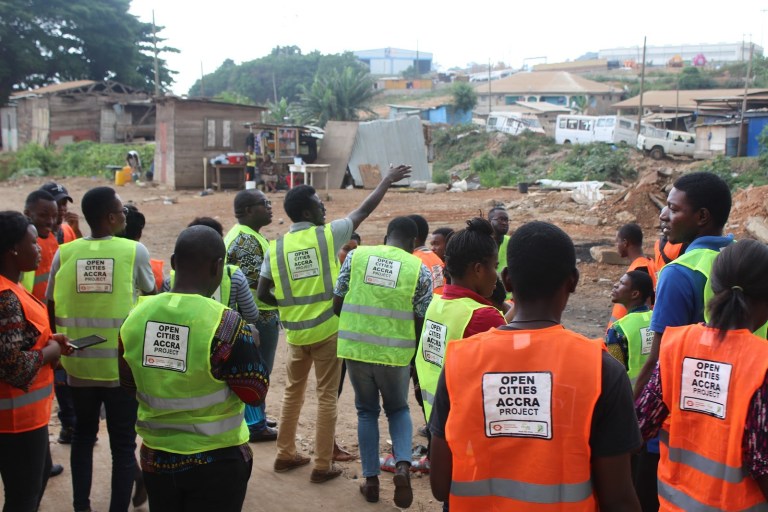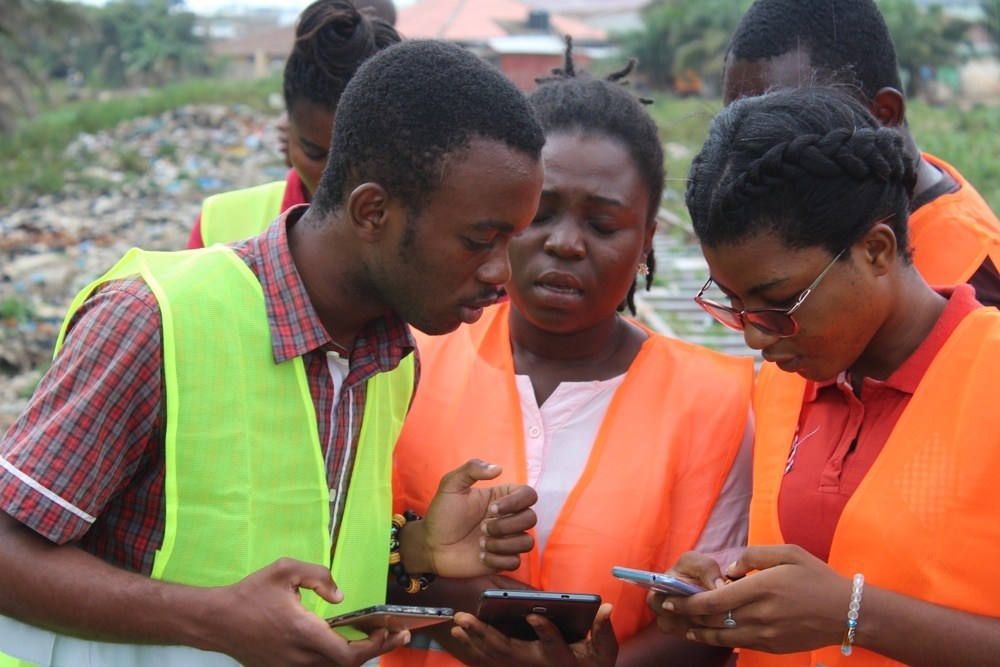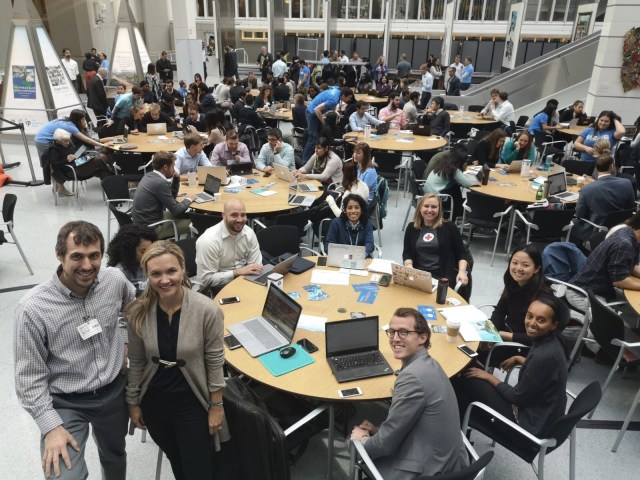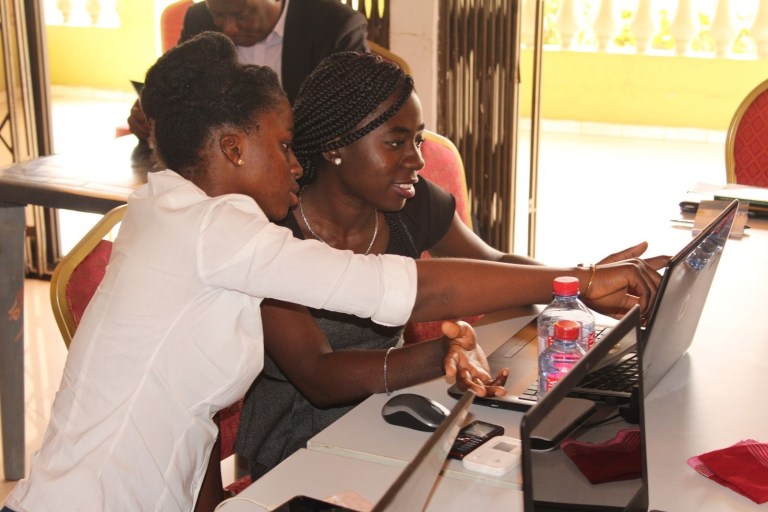My Experience as a Student Mapper for Open Cities Accra
Nov 15, 2018 | By

Field narrative by Chris Eshun, third-year Geomatic Engineering student and YouthMappers Training Coordinator at University of Mines and Technology. Chris a member of OSM Ghana and one of the participants of Open Cities Accra. Co-authored by Eli Sabblah, Project Coordinator at Mobile Web Ghana, David Luswata, Technical Advisor at Humanitarian OpenStreetMap Team (HOT), and Grace Doherty, Geospatial Consultant at OpenDRI Originally pulished here .
Open Cities Accra is supporting detailed mapping in Alogboshie community and its environs to improve resilience to natural disasters, especially flooding. Alogboshie, a suburb of Accra, is known to be one of the most flood-prone areas in Ghana’s capital city. Located along the Odaw River, Alogboshie is one of the four focus communities for the World Bank’s Greater Accra Climate Resilient and Integrated Development (GARID) project. Protecting Alogboshie will require an integrated approach that addresses drainage improvements, flood forecasting, solid waste management, improved urban planning and support to communities.
Geospatial data collection at Alogboshie has been a key activity for understanding flood risk and informing this integrated approach. The Open Cities Accra team – led by Humanitarian OpenStreetMap Team (HOT), Mobile Web Ghana and OpenStreetMap Ghana (OSM Ghana) – began remote and field mapping of Alogboshie in the summer of 2018.
 Student mappers in the field collect data using mobile survey apps
Student mappers in the field collect data using mobile survey apps
OpenStreetMap (OSM) is a freely accessible and editable map of the world, which means anyone can contribute to it and participate in a collaborative mapping workflow. But few gain the chance to see the other side of the collaborative mapping process: when field mappers take to the streets to survey critical infrastructure and hazard-prone sites.
We asked Chris Eshun, one of the mappers who worked on the Open Cities Accra project, to offer readers a first hand look at what it’s like to be part of a community mapping team in Ghana. This is what he had to share.
 Mappers at the World Bank Mapathon in Washington, DC remotely trace buildings for the area of Alajo in Greater Accra, Ghana
Mappers at the World Bank Mapathon in Washington, DC remotely trace buildings for the area of Alajo in Greater Accra, Ghana
Anyone can contribute to OpenStreetMap. But few gain the chance to see the other side of the collaborative mapping process: when field mappers take to the streets.
It was early August when Open Cities Accra convened mappers at the Mobile Web Ghana office for our first briefing and intensive training sessions. Our field team was diverse, with some experts in OSM and data collection and others completely new to the world of mapping. On the first day of training, they brought new mappers on par with the rest so we could all effectively help in mapping the area. We were taken through lessons in the aims and objectives of the project and the software – GIS and other tools – required to contribute to OSM.
Day 2 involved the remote mapping of Alogboshie. We used Java OpenStreetMap editor (JOSM) to map the areas of interest to the project, and mobile applications such as MAPS.ME, OSMTracker, OSMAnd, OpenMapKit, and OpenDataKit were also introduced to us. The Data Model required for the project was discussed and how the tools we had learnt about were going to play a major role in the data collection.
 Capacity building and training session
Capacity building and training session
On the third day, we were given the opportunity to test our skills in field data collection. This exercise was to help us familiarize ourselves with the data collection process. The mappers were dispatched in teams to collect geospatial data. The exercise was very useful in getting feedback and comments on ways to make the field data collection effective and efficient. On Day 4, we were divided into various teams and sent to Alogboshie, the main area of focus for the Open Cities Accra Project. The various teams had different sections to work in, using OpenDataKit and OpenMapKit for the data collection of details such as building materials, building levels, house address and other data required for the project.
On the last day of training we went back to the field again to develop strategies for all the teams involved to be used during the actual data collection exercise. During this exercise, the mappers were divided into two main teams, the data collection team and the data cleaning team. The data collection team was responsible for getting data from the field and the data cleaning team had to check and validate the data to reduce errors and mistakes.
The data being collected would go a long way to make the area resilient to floods and other natural disasters.
I realized the essence of data cleaning during this exercise especially because I was selected to be part of the data cleaning team. My team noticed quite a few errors in the data collected by members of the data collection team. These included wrong spelling of certain keywords and the repetition of entry of some data. The detection of all this was our duty and we came to the realization of how important it was to the general success of the project during this exercise.
After the training for the participants, work began and the various teams were tasked to do their individual work. The data collection team did their work with enthusiasm and from time to time those of us working in the data cleaning team also got data from the field to rectify and clean.
 Mappers taking instructions from the field supervisor, Enock Seth Nyamador
Mappers taking instructions from the field supervisor, Enock Seth Nyamador
The mappers had been taken through a lesson on how to interact with the people in the community therefore we were very much prepared to communicate the purpose of our exercise. A few of the mappers encountered some community members who weren’t too welcoming of us. Some of them asked questions especially because there had been some demolition works in the community not too long before our visit which affected some community members. The demolition works affected houses within 50-metre distance on either sides of the railway line because there was going to be a reconstruction of the railway line. However, the mappers explained to them what the Open Cities project is about and the fact that the data being collected would go a long way to make the area resilient to floods and other natural disasters.
Participating in the Open Cities Project has given me knowledge and skills in how I can use OpenStreetMap and other open source software to help solve similar problems that plague the community I am in. It has also given me more ideas on activities and projects that our YouthMappers Chapter in the University of Mines and Technology can undertake.
For more information about the Open Cities Accra project, follow our progress at Open Cities Africa - Accra
This article is a repost of published by: